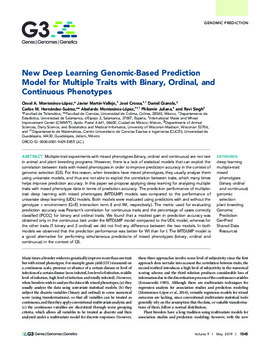Mostrar el registro sencillo del ítem
New deep learning genomic-based prediction model for multiple traits with binary, ordinal, and continuous phenotypes
| Autor: | Montesinos-Lopez, O.A. |
| Autor: | Martin-Vallejo, J. |
| Autor: | Crossa, J. |
| Autor: | Gianola, D. |
| Autor: | Hernández Suárez, C.M. |
| Autor: | Montesinos-Lopez, A. |
| Autor: | Juliana, P. |
| Autor: | Singh, R.P. |
| Año: | 2019 |
| ISSN: | 2160-1836 |
| URI: | https://hdl.handle.net/10883/20208 |
| Resumen: | Multiple-trait experiments with mixed phenotypes (binary, ordinal and continuous) are not rare in animal and plant breeding programs. However, there is a lack of statistical models that can exploit the correlation between traits with mixed phenotypes in order to improve prediction accuracy in the context of genomic selection (GS). For this reason, when breeders have mixed phenotypes, they usually analyze them using univariate models, and thus are not able to exploit the correlation between traits, which many times helps improve prediction accuracy. In this paper we propose applying deep learning for analyzing multiple traits with mixed phenotype data in terms of prediction accuracy. The prediction performance of multiple-trait deep learning with mixed phenotypes (MTDLMP) models was compared to the performance of univariate deep learning (UDL) models. Both models were evaluated using predictors with and without the genotype x environment (GxE) interaction term (I and WI, respectively). The metric used for evaluating prediction accuracy was Pearson's correlation for continuous traits and the percentage of cases correctly classified (PCCC) for binary and ordinal traits. We found that a modest gain in prediction accuracy was obtained only in the continuous trait under the MTDLMP model compared to the UDL model, whereas for the other traits (1 binary and 2 ordinal) we did not find any difference between the two models. In both models we observed that the prediction performance was better for WI than for I. The MTDLMP model is a good alternative for performing simultaneous predictions of mixed phenotypes (binary, ordinal and continuous) in the context of GS. |
| Formato: | |
| Lenguaje: | English |
| Editor: | Genetics Society of America |
| Copyright: | CIMMYT manages Intellectual Assets as International Public Goods. The user is free to download, print, store and share this work. In case you want to translate or create any other derivative work and share or distribute such translation/derivative work, please contact CIMMYT-Knowledge-Center@cgiar.org indicating the work you want to use and the kind of use you intend; CIMMYT will contact you with the suitable license for that purpose. |
| Tipo: | Article |
| Lugar de publicación: | Bethesda, MD (USA) |
| Páginas: | 1545-1556 |
| Número: | 5 |
| Volumen: | 9 |
| DOI: | 10.1534/g3.119.300585 |
| Palabras Claves: | Deep Learning |
| Palabras Claves: | Multiple-Trait |
| Palabras Claves: | Mixed Phenotypes (Binary Ordinal and Continuous) |
| Palabras Claves: | Genomic Selection |
| Palabras Claves: | Genomic Prediction |
| Palabras Claves: | GenPred |
| Palabras Claves: | Shared Data Resources |
| Agrovoc: | PHENOTYPES |
| Agrovoc: | GENOMICS |
| Agrovoc: | PLANT BREEDING |
| Datasets relacionados: | http://hdl.handle.net/11529/10548140 |
| Revista: | G3: Genes, Genomes, Genetics |
Ficheros en el ítem
Este ítem aparece en la(s) siguiente(s) colección(ones)
-
Genetic Resources
Genetic Resources including germplasm collections, wild relatives, genotyping, genomics, and IP -
Wheat
Wheat - breeding, phytopathology, physiology, quality, biotech

